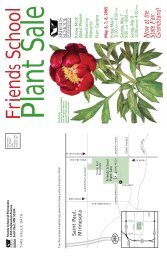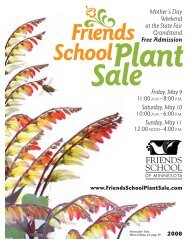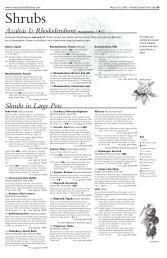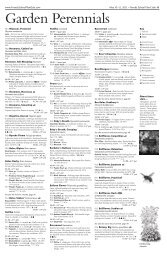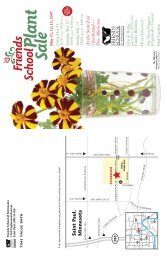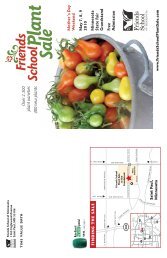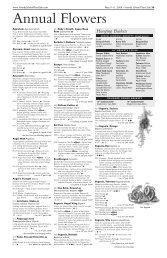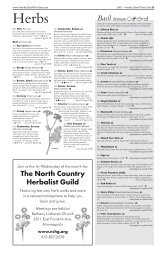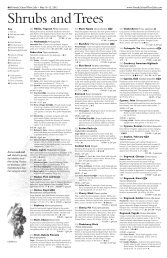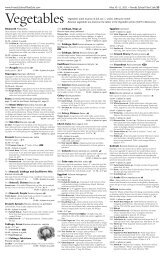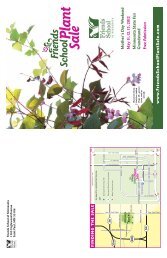View the 2013 56-page PDF here - Friends School Plant Sale
View the 2013 56-page PDF here - Friends School Plant Sale
View the 2013 56-page PDF here - Friends School Plant Sale
You also want an ePaper? Increase the reach of your titles
YUMPU automatically turns print PDFs into web optimized ePapers that Google loves.
www.<strong>Friends</strong><strong>School</strong><strong>Plant</strong><strong>Sale</strong>.com May 10–12, <strong>2013</strong> • <strong>Friends</strong> <strong>School</strong> <strong>Plant</strong> <strong>Sale</strong> 29<br />
What has gone wrong?<br />
Over <strong>the</strong> last 50 years, almost every change we have made as a<br />
society to how we live and how we farm has been unfriendly to bees.<br />
We have more concrete, more lawns, more pesticides, and more giant<br />
farms growing corn and soybeans. We have fewer weeds and fewer<br />
flowers. As individuals who care about <strong>the</strong> health of bees, <strong>the</strong>re are<br />
some things we can’t do much about (bee diseases, bee genetics) but<br />
as gardeners we have a powerful tool: that little piece of ground we<br />
call our own back yard. Make some simple changes, and <strong>the</strong>n persuade<br />
your neighbor and <strong>the</strong>ir neighbor to do <strong>the</strong> same. It will make<br />
a difference.<br />
What you can do<br />
Minimize your pesticide use. Learn to accept imperfection. Hand<br />
pull unwanted plants. Think of <strong>the</strong> “weeds” in your lawn (clover,<br />
chickweed, violets) as “grass companions.” Read about integrated<br />
pest management.<br />
<strong>Plant</strong> flowers that appeal to bees:<br />
flowers with landing platforms, single<br />
flowers, particularly in white, yellow, or<br />
blue. (Bees see in <strong>the</strong> ultraviolet range,<br />
which means <strong>the</strong>y don’t see red.) Be<br />
slow to deadhead because fading blooms<br />
still have nectar. <strong>Plant</strong> in clumps.<br />
<strong>Plant</strong> natives. This is an important<br />
one. Studies of bumble bees show that Native New England asters<br />
provide single flowers, visible<br />
<strong>the</strong>y prefer natives 4:1 over introduced color, a landing deck, and a lateseason<br />
nectar source for<br />
plants. Dense stands of native flowers<br />
honeybees like this one.<br />
give “more bang for <strong>the</strong> buzz.”<br />
<strong>Plant</strong> for succession (this is good for you as well as <strong>the</strong> bees). Try<br />
to have at least three things flowering in your garden at all times;<br />
critical times are early spring and late fall, think squill and crocuses,<br />
goldenrod and asters. Plan your yard vertically (canopy, understory,<br />
shrubs, ground layer) to fit in more plants. Reduce or get rid of your<br />
lawn.<br />
Include some nesting space for wild<br />
bees. Sixty to seventy percent are<br />
ground nesters; just leave an area of<br />
exposed, undisturbed soil. No mulch,<br />
sorry. Thirty to forty percent of native<br />
bees are cavity nesters; except for <strong>the</strong><br />
carpenter bees, native bees can’t excavate<br />
<strong>the</strong>ir own holes, so <strong>the</strong>y need ready-<br />
lengths can be grouped to create<br />
Bamboo sticks cut to short<br />
made tunnels. Consider a bee house a bee nest.<br />
made of ei<strong>the</strong>r an untreated, drilled wood<br />
block or hollow sticks. Leave rotting dead wood in your yard.<br />
Read. Educate yourself. Educate your neighbor (if your neighbor<br />
is using pesticides, <strong>the</strong>y’re ending up in your yard).<br />
Consider becoming a beekeeper. Really, why not? Find information<br />
at www.beesquad.umn.edu.<br />
Support local research. As gardeners, we are lucky to have a<br />
world class bee lab on <strong>the</strong> Saint Paul campus of <strong>the</strong> University of<br />
Minnesota, w<strong>here</strong> <strong>the</strong> goal is to “get bees back on <strong>the</strong>ir own six feet.”<br />
Run by Marla Spivak, a MacArthur fellow and professor of<br />
Entomology at <strong>the</strong> U, <strong>the</strong> bee lab runs classes, does research, works<br />
with beekeepers, and has big plans for <strong>the</strong> future. Get involved!<br />
Resources<br />
www.beelab.umn.edu—Researchers from <strong>the</strong><br />
U of M will be on hand in <strong>the</strong> Garden Fair to<br />
answer questions about bees and plants for<br />
bee habitat. See <strong>page</strong> 4 for schedule.<br />
www.greatsunflower.org<br />
www.pollinator.org<br />
www.xerces.org<br />
www.queenof<strong>the</strong>sun.com—a documentary film<br />
about bee colony collapse disorder<br />
“Pollinators are what ecologists call keystone species.<br />
You know how an arch has a keystone, it’s <strong>the</strong> one stone that<br />
keeps <strong>the</strong> two halves of <strong>the</strong> arch toge<strong>the</strong>r. If you remove <strong>the</strong><br />
keystone, <strong>the</strong> whole arch collapses.” May Berenbaum<br />
PHOTO BY JOEL GARDNER PHOTO BY PAT THOMPSON<br />
A small carpenter bee<br />
comes in for a landing.<br />
Photo by Karl Foord<br />
Seed Savers List<br />
Seed Savers Exchange will be located by <strong>the</strong><br />
central stairway within <strong>the</strong> vegetable section.<br />
They will be at <strong>the</strong> sale on Friday and Saturday only!<br />
Seeds will NOT be available during Sunday’s discount sale.<br />
SSE will be selling <strong>the</strong>se varieties for $2.50 per pack:<br />
VEGETABLE SEEDS<br />
With seeds, you can plant multiple<br />
times to get fresh crops over <strong>the</strong><br />
season. You can also do a second<br />
planting of many spring vegetables<br />
in late summer for a fall harvest.<br />
<strong>Plant</strong>ing times for direct seeding<br />
into <strong>the</strong> ground, both in spring and<br />
late summer, are shown in italic.<br />
Arugula<br />
April–early May, August–Sept.<br />
Arugula Ø<br />
Apollo<br />
Asian Greens<br />
April–early May, August–Sept.<br />
Mizuna Ø<br />
Prize Choy Ø<br />
Tatsoi Ø<br />
Beans<br />
June–July<br />
Black Valentine<br />
Bountiful<br />
Calypso Ø<br />
Cherokee Trail of Tears<br />
Climbing French<br />
Dragon’s Tongue<br />
Empress Ø<br />
Fin de Bagnol Ø<br />
Ideal Market Ø<br />
Kentucky Wonder Bush<br />
Kentucky Wonder Pole<br />
Pencil Pod Golden Wax<br />
Provider Ø<br />
Purple Podded Pole Ø<br />
Rattlesnake Snap Ø<br />
Speckled Cranberry Ø<br />
Tiger’s Eye<br />
True Red Cranberry Ø<br />
Beets<br />
Mid-April–July<br />
Bull’s Blood<br />
Burpee’s Golden Ø<br />
Chioggia<br />
Detroit Dark Red<br />
Early Blood Turnip Ø<br />
Carrots<br />
Late April–late June<br />
Danvers Ø<br />
Dragon<br />
Jaune du Doubs ◊<br />
Paris Market<br />
Scarlet Nantes<br />
St. Valery<br />
Chard<br />
Mid-April–July<br />
Five Color Silverbeet Ø<br />
Corn<br />
End of May, first 2 weeks of June<br />
Blue Jade Ø<br />
Country Gentleman Ø<br />
Golden Bantam Ø<br />
Mixed Colors Broomcorn<br />
Stowell’s Evergreen Ø<br />
Tom Thumb Popcorn Ø<br />
Two Inch Strawberry<br />
Popcorn Ø<br />
Cucumbers<br />
End of May–third week of July<br />
A & C Pickling Ø<br />
Bushy Ø<br />
Crystal Apple Ø<br />
Double Yield Ø<br />
Early Fortune Ø<br />
Edmonson Ø<br />
Holland White ◊<br />
Japanese Climbing Ø<br />
Longfellow Ø<br />
Mexican Sour Gherkin<br />
Parade Ø<br />
Parisian Pickling Ø<br />
Poona Kheera Ø<br />
Russian Pickling Ø<br />
True Lemon Ø<br />
Endive<br />
Late April–early May, August<br />
Très Fine Maraîchère Ø<br />
Kohlrabi<br />
Late April–early May, August–Sept.<br />
Purple Vienna Ø<br />
White Vienna Ø<br />
Lettuce<br />
Mid-April–early June,<br />
late August–Labor Day<br />
Amish Deer Tongue<br />
Baby Oakleaf Ø<br />
Baquieu Ø ◊<br />
Crisp Mint Ø<br />
Ella Kropf Ø ◊<br />
Forellenschluss<br />
Grandpa Admire’s Ø<br />
Red Romaine Ø<br />
Rossa di Trento<br />
Slobolt Ø<br />
SSE Lettuce Mixture<br />
Tennis Ball Ø<br />
Three Heart Ø ◊<br />
Winter Density Ø<br />
Yugoslavian Red Butterhead<br />
Lima Beans<br />
Early June–July<br />
Christmas<br />
Henderson Bush<br />
Melons<br />
Early June<br />
Minnesota Midget Ø<br />
Pride of Wisconsin<br />
Okra<br />
Mid-June–July<br />
Hill Country Red<br />
Peas<br />
Late April–early May<br />
Amish Snap<br />
Champion of England<br />
Dwarf Gray Sugar<br />
Golden Sweet Ø<br />
Green Arrow Ø<br />
Tom Thumb<br />
Pumpkins<br />
Late May–early June<br />
Amish Pie<br />
Cornfield Pumpkin<br />
Visit www.<strong>Friends</strong><strong>School</strong><strong>Plant</strong><strong>Sale</strong>.com/sse<strong>2013</strong><br />
for links to descriptions of <strong>the</strong>se heirloom varieties.<br />
Save Your Own Seeds<br />
You can save your own open-pollinated seeds from year<br />
to year. Get started by attending one of <strong>the</strong> demonstra -<br />
tions Seed Savers Exchange will be doing in <strong>the</strong> Garden<br />
Fair (see <strong>page</strong> 5 for schedule).<br />
Radishes<br />
Late April–early May, mid-<br />
August<br />
China Rose ◊<br />
Cincinnati Market<br />
Early Scarlet Globe<br />
French Breakfast Ø<br />
Plum Purple<br />
White Icicle ◊<br />
Shallot<br />
Late May, early June<br />
Zebrune ◊<br />
Soybeans<br />
Mid-May–early June<br />
Fiskeby Ø<br />
Shirofumi Ø<br />
Spinach<br />
Late April–early May, August<br />
America<br />
Bloomsdale Ø<br />
New Zealand<br />
Squash, Summer<br />
Late May, early June<br />
Black Beauty Zucchini Ø<br />
Golden Zucchini<br />
Summer Crookneck Ø<br />
Squash, Winter<br />
Late May, early June<br />
Burgess Buttercup Ø<br />
Pennsylvania Dutch<br />
Crookneck<br />
Potimarron ◊<br />
Table Queen<br />
Thelma Sanders Ø<br />
Waltham Butternut Ø<br />
Winter Luxury Ø ◊<br />
Zebrune<br />
Turnips<br />
Early April, late July–early August<br />
Purple Top<br />
White Globe<br />
Watermelons<br />
Early June<br />
Blacktail Mountain Ø<br />
Golden Midget<br />
Moon & Stars Ø<br />
FLOWER SEEDS<br />
Bachelor Buttons: Blue Boy<br />
Bee’s Friend Ω Phacelia<br />
Calendula: mixture<br />
California Poppy: mixture<br />
Cosmos Ω: Diablo; Sensation<br />
mixture; Sea Shells<br />
Globe Amaranth: mixture<br />
Hyacinth Bean: Ruby Moon<br />
Kiss-Me-Over-<strong>the</strong>-Garden-Gate<br />
Marigold: Red Marietta<br />
Morning Glory: Grandpa Ott’s<br />
Nasturtium: Black Velvet;<br />
Tip Top<br />
Sunflowers Ω: Evening Sun; Lemon<br />
Queen; Orange Sun; Ring of Fire;<br />
Taiyo; Titan; Valentine<br />
Sweet Peas: Grandiflora Mix<br />
Zinnia: Persian Carpets





